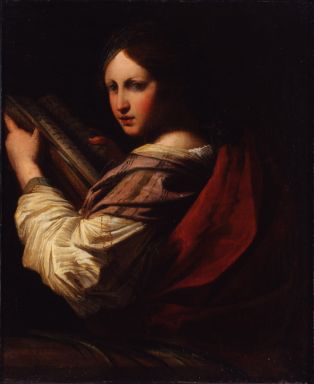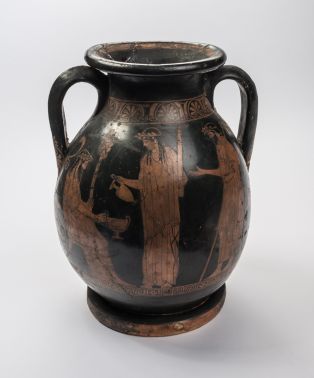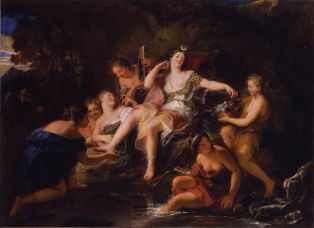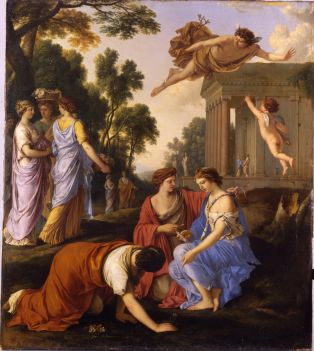- Découvrez les collections
- Notice d'oeuvre



Paris, 1606 ; Paris, 1656
1649
H. 144 cm ; l. 127 cm (sans cadre) ; H. 164 cm ; l. 147,5 cm (avec cadre)
M0536_L.I.32
Cette œuvre est caractéristique du travail de Laurent de La Hyre, l'un des artistes majeurs du XVIIe siècle français. Elle met en scène Mercure, fils de Jupiter, reconnaissable à ses attributs iconographiques : le couvre-chef ailé, appelé le pétase, les ailes aux chevilles ainsi que le caducée, symbole de la paix. Cupidon, dieu de l’amour, lui décoche une flèche, qui le rend aussitôt amoureux d’Hersé. Cette dernière est représentée au second plan avec ses compagnes, vêtue d’un drapé rose. Les jeux de regards et les mouvements des personnages aident à percevoir le déroulement de l’action. Le groupe au premier plan comprend sans doute Aglaure, la sœur d’Hersé. Ce tableau s'inscrit dans le mouvement pictural de l'Atticisme, auquel La Hyre adhère dans la deuxième partie de sa carrière. Ce courant, né en France à la fin du XVIIe siècle, dérive du Classicisme avec lequel il partage l'intérêt pour l'Antiquité. Les œuvres de ce mouvement recherchent l’harmonie, la pureté, mêlant réalisme et élégance, douceur et calme.
This painting is typical of the work of Laurent de La Hyre, one of the great 17th century French artists. It depicts Mercury, the son of Jupiter, who can be identified by his iconographic attributes: a winged helmet, known as a petasus, winged heels, and a caduceus, a symbol of peace. Cupid, the god of love, fires an arrow at him which makes him fall in love with Herse. Herse is depicted in the background draped in pink, with her female companions. The interplay of the characters’ glances and movements provides a clue to the plot of the story. The group in the foreground probably includes Aglauros, Herse’s sister. The painting belongs to the Attic school, of which La Hyre was an exponent in the latter half of his career. This movement, which was born in France in the late 17th century, is an offshoot of Classicism, with which it shares an interest in Antiquity. Works belonging to this movement strive for harmony and purity, with a blend of realism and elegance, gentleness and calm.
This painting is typical of the work of Laurent de La Hyre, one of the great 17th century French artists. It depicts Mercury, the son of Jupiter, who can be identified by his iconographic attributes: a winged helmet, known as a petasus, winged heels, and a caduceus, a symbol of peace. Cupid, the god of love, fires an arrow at him which makes him fall in love with Herse. Herse is depicted in the background draped in pink, with her female companions. The interplay of the characters’ glances and movements provides a clue to the plot of the story. The group in the foreground probably includes Aglauros, Herse’s sister. The painting belongs to the Attic school, of which La Hyre was an exponent in the latter half of his career. This movement, which was born in France in the late 17th century, is an offshoot of Classicism, with which it shares an interest in Antiquity. Works belonging to this movement strive for harmony and purity, with a blend of realism and elegance, gentleness and calm.
Mercure, le messager des dieux, aperçoit la belle Hersé et en tombe amoureux. Si l’artiste a donné une représentation paisible de cet épisode des "Métamorphoses d’Ovide", cette histoire d’amour vire ensuite au drame : en effet, Aglaure est prise par la jalousie et tente d’empêcher Mercure d’entrer dans la chambre de sa soeur ; le dieu change alors Aglaure en pierre sombre. Les amours des dieux mythologiques n’ont pas une valeur d’édification, d’exemple pour les mortels. Guidés par leurs passions, ils œuvrent simplement pour les assouvir, personnifiant ainsi la nature, procréatrice et violente.
Mercury, the messenger of the gods, sees the beautiful Herse and falls in love with her. Although the artist created a peaceful portrayal of this episode from "Ovid’s Metamorphoses", this love story later takes a tragic turn: consumed with jealousy, Aglauros tries to prevent Mercury from entering her sister’s bedroom; the god then turns Aglauros into dark stone. The love affairs of the mythological gods hold no educational value for anyone, such as mortals. Driven by their passions, the gods merely seek to satisfy them, and personify procreative and violent nature in so doing.
Mercury, the messenger of the gods, sees the beautiful Herse and falls in love with her. Although the artist created a peaceful portrayal of this episode from "Ovid’s Metamorphoses", this love story later takes a tragic turn: consumed with jealousy, Aglauros tries to prevent Mercury from entering her sister’s bedroom; the god then turns Aglauros into dark stone. The love affairs of the mythological gods hold no educational value for anyone, such as mortals. Driven by their passions, the gods merely seek to satisfy them, and personify procreative and violent nature in so doing.





 Copyright© WebMuseo 2017 - 2024
Copyright© WebMuseo 2017 - 2024